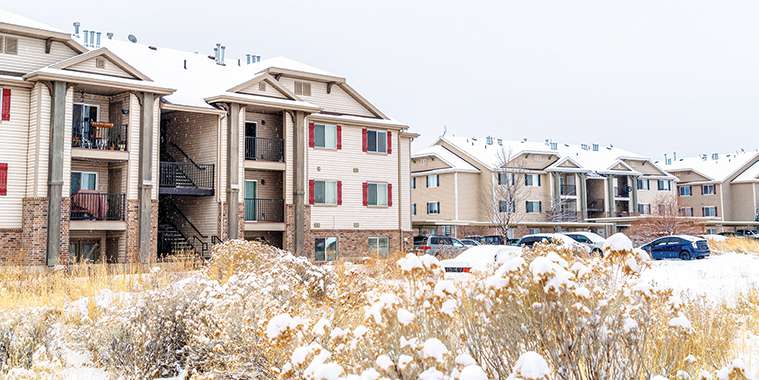A well-served housing market means different things for different cities — and, on a more granular level, different neighbourhoods. Some people benefit more from multi-family buildings, others are better served by a larger share of single-family homes. One trend in many major Canadian markets is missing middle housing, even in those that stand to benefit from it.
What is middle housing?
Middle housing includes duplexes, triplexes, quadplexes, townhomes, cottage courts, and laneway homes — it’s the middle ground between multi-family apartments or condos and single-family homes. Middle housing tends to be more affordable and requires a similar amount of land as single-family homes, while offering more density.
However, because of specific policies in place, middle housing is often missing from major Canadian cities. As the housing supply crisis looms, middle housing has the ability to be something of a solution.
Delivering housing supply that’s diverse and attainable is something that the Canadian Real Estate Association (CREA) actively advocates for. One of their “Real Ideas” for doing so includes the creation of a national roundtable — involving all levels of government, builders, real estate professionals, and civil society organizations — where all players inform solutions to the supply crisis, including how to best utilize “the entire housing spectrum.” Another idea involves using the federal government’s Investing in Canada Infrastructure Program to “create new housing that’s indexed to population growth” and delegate individual municipalities to “make decisions to better serve the unique needs of their communities.”
The missing middle and the housing supply crisis
As the population expands, Canada continues to suffer from a housing supply crisis. The integration of middle housing is a way to reshape existing neighbourhoods so they can serve more Canadians — particularly immigrants, young people, and low-income earners.
In theory, middle housing can also be a way to revitalize old or hollowed-out neighbourhoods. Plus, if those neighbourhoods are near central city amenities or well-served by public transit, middle housing can go hand-in-hand with the idea of “complete cities” where the need for vehicle use is less.
In these ways, middle housing stands to make the housing market more inclusive for a more diverse demographic of homeowners and renters, and is a savvy way for cities to work around the new development process, which can often be lengthy, costly, environmentally detrimental, and laced with bureaucratic red tape.
Why isn’t there more middle housing?
The answer tracks back to very intentional zoning policies put in place in major Canadian cities. For example, in pre-Second World War Toronto, neighbourhoods were made up of a mix of duplexes, apartment buildings, and single-family homes. But after the war, strict zoning policies were put in place mandating entire neighbourhoods of single-family homes, and others that were entirely multi-family. To this day, zoning bylaws remain restrictive and are often supported by the idea of maintaining the character of neighbourhoods.
The policies that have prevented middle housing from being built are outdated and unreflective of the Canadian population as it is now. Given that little has changed in the ways of such zoning policies in several decades, CREA believes that the federal government has an opportunity to make policy changes that will reflect how the population has shifted and a growing need for affordable housing, including housing supply. CREA also urges the federal government to empower municipalities to assess their own housing supply needs and make such policy adjustments on smaller scales.
“The problem of high housing demand amid low supply hasn’t gone anywhere. The COVID-19 pandemic at least shone a big spotlight on it,” said CREA’s Senior Economist in a recent CREA Café article.
“If you want to have record-level population growth at a time when the population is also becoming increasingly middle-aged, you need the housing stock to keep up because people need to live somewhere. Actually getting those units built is the not-so-simple part, as evidenced by the fact that the medium-density housing (also known as gentle density housing) we all agreed a decade ago was the way forward is still referred to as the ‘missing’ middle.”
Initiatives to address the missing middle in Canadian cities
Although changing zoning policies that have been in place for close to 80 years isn’t so simple, rethinking those policies can help address the missing middle.
For instance, the City of Toronto officially greenlit laneway suites back in 2018. Meanwhile, Victoria has been something of a trailblazer when it comes to middle housing; not only is the city’s existing zoning inclusive of sixplexes, but city council is currently considering a Missing Middle Housing Initiative — a proposal to replace single-family property zoning with more flexible zoning that would lend itself to middle housing development.
Provincial governments are also taking action in making it easier to create a more diverse array of housing that addresses the missing middle. In October, the Ontario provincial government introduced the More Homes Built Faster Act, which, if passed, would allow up to three residential units on most land zoned for one home in residential areas. This legislation was designed to cut through municipal red tape and fast track attainable housing options.
Addressing missing middle housing could be part of the solution when it comes to the housing supply shortage, allowing more Canadians to enter the housing market and experience homeownership while making communities more inclusive.
— CREA.ca



